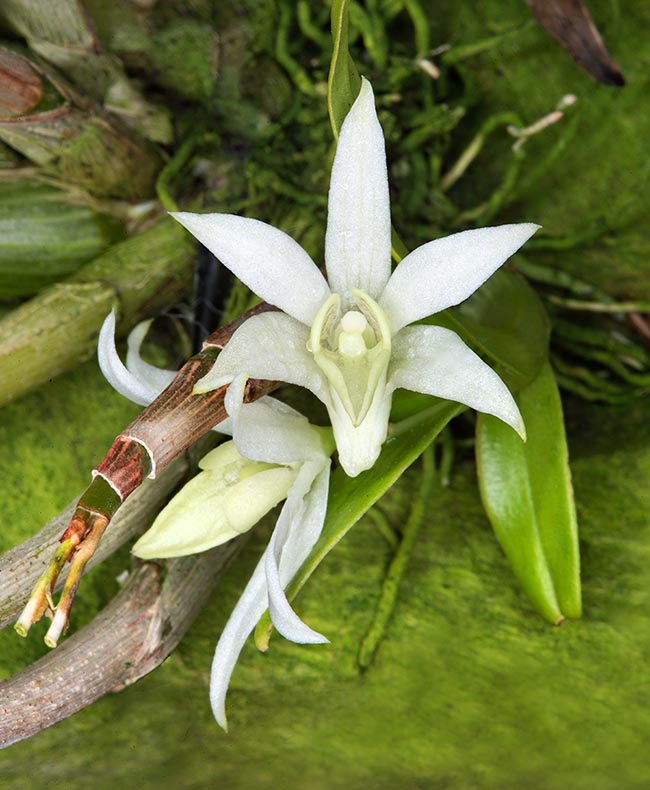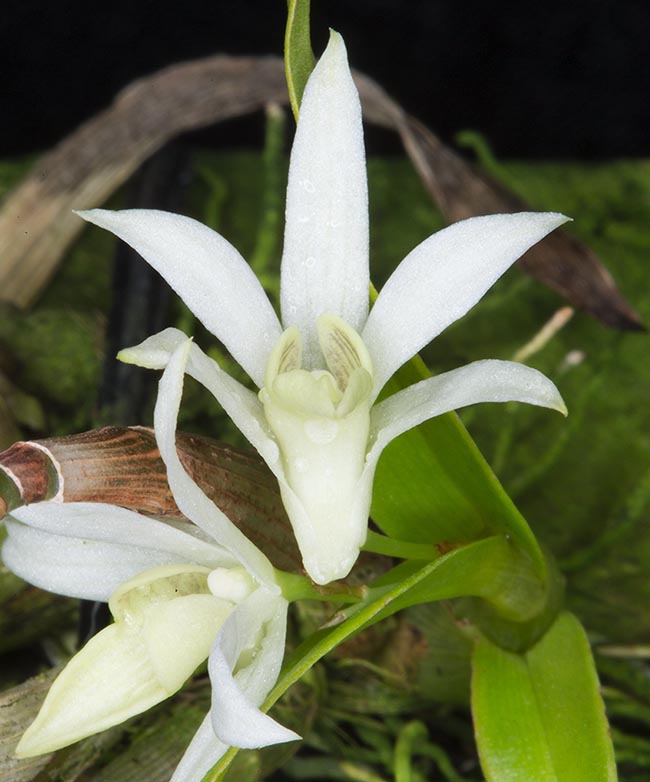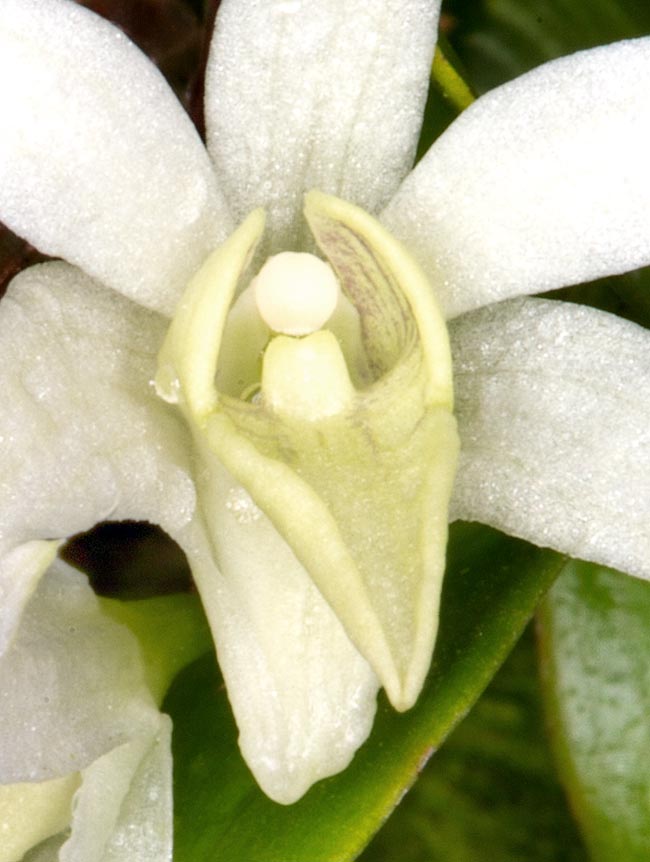Family : Orchidaceae

Text © Prof. Pietro Pavone

English translation by Mario Beltramini

Mini epiphytic orchid, Dendrobium compactum grows in Myanmar, Thailand and in China © Giuseppe Mazza
Dendrobium compactum Rolfe ex Hemsl. is a species identified by the English botanist Robert Allen Rolfe (1855-1921), but validly described by William Botting Hemsley (1843-1924) in “The Gardeners’ chronicle” London, a weekly illustrated periodical of horticulture.
In the article Hemsley relates that it was Madame Louise de Hemptinne of Gand who sent a flowering specimen of this orchid, in 1903, to Rolfe, curator of the orchidological herbarium of Kew Royal Botanic Gardens, who immediately recognized it as a new species and gave it the name of Dendrobium compactum, without describing it at all. Conversely, it was Hemsely who correctly described this species in Gard. Cgron., ser. 3,36: 400 (1904).
Dendrobium compactum belongs to the section Stachyobium, family of Orchidaceae, to the subfamily Epidendroideae, tribe Malaxideae, subtribe Dendrobiinae.
It is found in Myanmar, in northern Thailand, in the Chinese province of Yunnan and in south-western China.
The name of the genus is the combination of the Greek substantives “δένδρον” (dendron), tree, and “βίος” (bios), life, due to the numerous species of the genus living in the trees getting nourishment from the humid atmosphere, typical to the equatorial forests.
The specific epithet, from the Latin compactum, compact, refers to the size of the plant.
The common name is Compact dendrobium. In China it is called Cao Shi Hu (草石斛) and in Thailand, Uerang Khao Tok.
It is an epiphytic species growing from 800 to 1900 metres of altitude in the mountain forests subject to a marked dry season.
It is found on the trunks of dipterocarp (Dipterocarpus tuberculatus Roxb., Dipterocarpus obtusifolius Teijsm.ex Miq.) and of other deciduous tree species with open and irregular crowns.

The tiny flowers, measuring only 0,7 mm with luminous sepals and pointed petals, bloom between 800 and 1900 m of altitude on the trunks of the trees in the mountain forests subject to a marked dry season © Giuseppe Mazza
Dendrobium compactum is a species with cylindrical, fusiform, fleshy, erect, 1,5-3 cm long, pseudobulbs.
The young stems are 3 to 10 cm long and are enclosed by the leaf sheaths, whilst those of the previous year are bare and are of golden yellow colour.
On the apical part are present 2 to 5 leaves, distichous, alternate, the lower smaller than the upper ones, 1-2,5 x 0,4-0,6, or more, cm, with the base dilated in sheaths and obtuse apex and unequally bilobate.
The Inflorescences grow in the upper part of the young stem (of the current year) and are sub-terminal or lateral tacemes, erect, usually 1-2 cm, usually not exceeding the leaves, with 3-6 flowers and floral ovate-lanceolate bracts.
The flowers, lasting about two weeks, are small (0,7 cm), expanded, white with pale green labellum.
The dorsal sepal is ovate-oblong, 4 x 1,8 mm, with three veins and the lateral sepals aez lanceolate, 4 x 3,5 mm, with three or four veins, oblique base, acute apex. The mentum is conical.
The petals are sub-urbicular, 4 x 1,7 mm, with slightly wavy margin and acute apex.
The labellum is sub-urbicular, 5 x 4 mm, inconspicuous, with 3 lobes.
The margin is finely crested-wavy, toothed at the centre, with median lobe slightly ovate-triangular and mucronate margin.
The disk of the labellum has fleshy crests formed by 2 or 3 lamellae.
The column is of about 2 mm with the upper part enlarged with the cap of the anther widely conical and with fore margin slightly toothed. The pedicel and the ovary are 4 mm long.
Blooming occurs from September to December. The fruit is an ovoidal capsule, of 5 mm of diameter, with 3 veins.

Close up of the labellum with fleshy crests. Hybrids and several cultivars exist © Giuseppe Mazza
LIke many other species of orchids also Dendrobium compactum has developed the strategy of the photosynthesis of Acid Metabolism of the Crassulaceae, rightly called CAM).
This kind of photosynthesis is an adaptation to the excessive loss of water because the process of photosynthesis happens with closed stomata that, instead, open during the night for the gas exchanges (CO2, O2) with a minimum waste of water vapour.
It is a species protected from trade and as such is inserted in the Appendix II of Washington Convention (CITES) that has the aim to protect the animal and vegetable species under risk of extinction, hindering their export and detention.
Hybrids and several cultivars of Dendrobium compactum do exist.
Dendrobium Mukesh Ambani is a hybrid obtained by Pop through crossing between Dendrobium compactum × Dendrobium Jaquelyn Thomas and registered by Toh Garden in 2014 in the International Orchid Register.
Among the cultivars recently awarded we mention: Dendrobium compactum ‘Geka’ awarded by the Deutsche Orchideen Gesellschaft in 2014 and Dendrobium compactum ‘Munchie’ awarded by The American Orchid Society in 1989.
Dendrobium compactum is a very pretty and interesting species because of its small size.
It can be cultivated in warm environments (18-22 °C) with good light but not in direct sun.
In summer it is to be irrigated regularly and fertilized monthly, whilst in winter the waterings are to be reduced until when the new buds do appear.
For the growth substratum it is preferable to utilize a well drained mix of sphagnum moss and of fir bark.
Synonyms: Dendrobium wilmsianum Schlechter.
